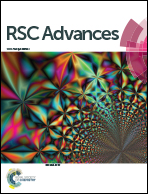Facile fabrication of centimeter-scale stripes with inverse-opal photonic crystals structure and analysis of formation mechanism†
Abstract
Due to their excellent photonic characteristics, colloidal crystals with periodic porous structures have attracted attention in fields such as bioseparation and photonic devices. In this work, we report a facile method to fabricate ultra-long colloidal crystal stripes with opal and inversed-opal structures. The colloidal crystal stripes were grown in a self-assembly process between polymeric microspheres (∼450 nm in diameter) and silica particles (14 nm ± 5 nm), and formed during vertical evaporation of the solvent. The as-grown colloidal crystal stripes can be automatically curled and peeled from the glass substrate. The polymeric spheres were subsequently removed by sintering the composite under 500 °C, yielding porous stripes with inverse-opal structures. Polystyrene-block-poly-(methyl methacrylate)-block-poly-(acrylic acid) (P(St-MMA-AA)) composite microspheres were synthesized to be used as polymeric microspheres in this process. To successfully fabricate ICPC stripes, the continuous colloidal film must be pinned on the substrate surface, directional self-assembly of colloidal particles must occur, and there must be strong interaction among colloidal particles with sufficient magnitude of inner stress. Displaying characteristics such as centimeter-scale length, a periodic porous structure, and structural colors, these stripes have potential applications in bioanalysis, optical guides, and novel photonic devices.


 Please wait while we load your content...
Please wait while we load your content...